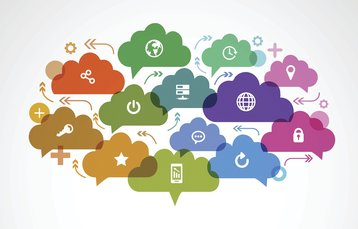As 2017 comes to a close, we find ourselves considering various New Year’s resolutions. We might purchase a gym membership, personal training classes, an e-reader, a bunch of books and a fancy juicer, but I’m sure we won’t receive the value of all these purchases as we’ll likely drop most of these habits (if not all) before the end of January.
Unfortunately, we see a similar pattern in IT. Well-intentioned organizations invest in promising technology and programs and end up spending more than they bargained for, or aren’t able to get the desired return.
Data center consolidation, cloud migration, hybrid and multi-cloud, application modernization, containers, microservices, artificial intelligence and machine learning, IoT, and analytics are just some of the recent initiatives enterprises have undertaken. Most predictions that I have read foresee increases in these areas (which is likely going to be true); however, it’s important to separate an increase in investments and an increase in return from these initiatives.
As we plan our IT initiatives for the coming year, it is critical that we set realistic expectations and goals. Instead of jumping on the hype train for all this promising technology, I’d like to offer some tempered, realistic predictions for enterprise IT organizations in 2018.
1. AI will not be a game changer… yet
While AI and machine learning undoubtedly have incredible potential, 2018 will see them applied too broadly and in areas where they are well suited. Make no mistake, there will be learnings and advancements next year that will be critical for the evolution of this technology, but let’s not get too caught up in the hype.
I know, it’s easy to play the part of a contrarian, but as somebody who works with those on the bleeding edge of AI and machine learning, I have a front row seat at the practical impacts this technology has on a company.
The technology is proving to be valuable, but the difference between the results of AI and traditional technology is marginal at best. Sorry to be the naysayer, but enterprises won’t seize ruthless speed or innovation due to AI in 2018.
2. Digital transformation initiatives will be stripped back
Enterprises are trying to boil the ocean right now. They are making radical changes in infrastructure, applications, architectures, processes, and culture. While there are merits behind each initiative, there often isn’t a targeted business result.
In 2018, enterprises will take account and temper many of their digital transformation initiatives. IT organizations will become more focused on completing digital transformation initiatives, instead of embarking on more. Separating the hype from reality in regards to digital transformation will cause enterprises to take a step back, which is actually a good thing.
3. Containers will come to the fore
There is undeniably a strong relationship between containers and microservices, and they are often referred to interchangeably. But this is a problem. In practice, these technologies couldn’t be more different, not least because containers are easy to implement whereas microservices are most certainly not.
It is now trivial to package a traditional application into a container, and container platforms have matured to a point where deployment of containers is a seamless experience. Running an application within a container or deploying a container into production is still light years away from using a microservices application in production.
When we talk of microservices, we specifically mean an application architecture where each function of the application operates as an independent service. These distributed applications are comprised of thousands of containers and need many network, application and security services to run effectively. Consider if you will that a container can be represented as a brick; microservices would therefore be a thriving capital city with advanced water, electricity and internet infrastructure. They are simply not the same and so should not be used interchangeably.
While containers will go mainstream in 2018, the same cannot be said for microservices. The year will see organizations make huge leaps forward in their use of containers, and hopefully with that will come a greater understanding of the differences between containers and microservices.
4. Enterprises will pursue a true hybrid or multi-cloud environment with only two clouds
There is a lot of cloud washing around hybrid and multi-cloud terms. Enterprises have expanded the number of data centers and clouds in the previous years; however, these operate as a discrete environment for a subset of the organization’s applications. It’s not uncommon to see situations where greenfield applications are born in the cloud and brownfield applications reside in the data center, and often zero portability between the two environments. A set up such as this simply cannot be described as hybrid.
True hybrid or multi-cloud environments are homogeneous, meaning it is a single environment comprised of multiple infrastructure providers. In a true hybrid or multi-cloud environment it will be easy to move applications between data centers and clouds. As organizations look to avoid lock-in, adopting a homogeneous environment has to be the way forward. Portability for all applications across multiple environments gives enterprises the freedom to run their applications in the best possible environment, without consequences if circumstances change (e.g. availability, cost, features).
The upcoming year will see more and more organizations look to adopt a hybrid cloud or multi-cloud strategy, as they combine their own data center/private cloud with the most advanced public clouds of AWS or Azure.
5. The next wave of hardware appliances will get rooted out of the data center
Yes, my previous predictions are a reserved (read: realistic) take on the biggest trends in the industry. Let me diverge from that theme with this prediction. Hardware is dying.
Nobody wants to manage or think about hardware appliances anymore. They are expensive, complex, and function counter to the speed and elasticity that enterprises are driving towards. The biggest trends in IT are all driven by technology that abstracts away hardware dependency — namely cloud infrastructure and containers.
The data center used to be completely confined to hardware. Then virtualization began chipping away at hardware’s grasp on the data center. Today, many consider their data centers to be software-defined. In 2018, we’ll see another wave of proprietary hardware that will get displaced as enterprises commit to speed, automation, and elasticity. Application delivery controllers and web application firewalls are among the hardware appliances that will get the axe in 2018 as software solutions offer better performance and pricing and can run on existing x86 hardware or white boxes.
This will be the biggest shift towards software in the data center since virtualization and will continue gradually over the next few years until enterprises transition entirely to the cloud or software can replace all hardware appliances, including firewalls, IDS, and IPS appliances.
Dirk Marichal is VP of EMEA & India at Avi Networks, a developer of software for the delivery of enterprise applications



